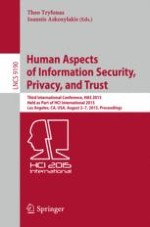This book constitutes the proceedings of the Third International Conference on Human Aspects of Information Security, Privacy, and Trust, HAS 2015, held as part of the 17th International Conference on Human-Computer Interaction, HCII 2015, held in Los Angeles, CA, USA, in August 2015 and received a total of 4843 submissions, of which 1462 papers and 246 posters were accepted for publication after a careful reviewing process. These papers address the latest research and development efforts and highlight the human aspects of design and use of computing systems. The papers thoroughly cover the entire field of Human-Computer Interaction, addressing major advances in knowledge and effective use of computers in a variety of application areas. The 62 papers presented in the HAS 2015 proceedings are organized in topical sections as follows: authentication, cybersecurity, privacy, security, and user behavior, security in social media and smart technologies, and security technologies.
